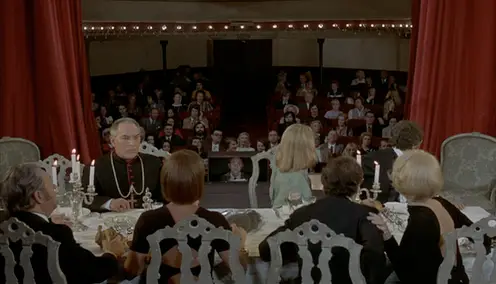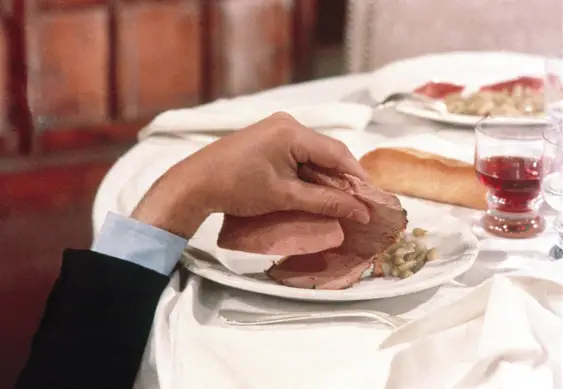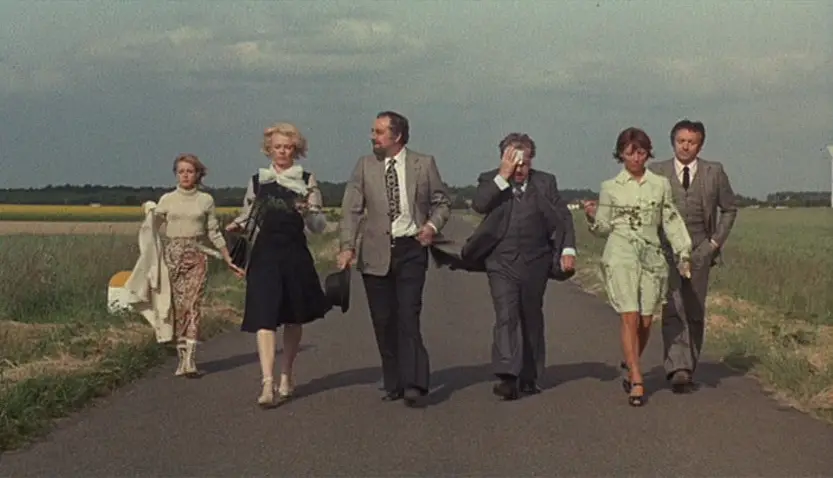
Director: Luis Bunuel
Producer: Serge Silberman (Dean, Greenwich, Jet)
Writer: Luis Bunuel, Jean-Claude Carriere
Photography: Edmond Richard
Cast: Fernando Rey, Paul Frankeur, Delphine Seyrig, Bulle Ogier, Stephane Audran, Jean-Pierre Cassel, Julien Bertheau, Milena Vukotic, Maria Gabriella Malone, Claude Pieplu, Muni, Pierre Maguelon, Francois Maistre, Michel Piccoli, Ellen Bahl
![]()
It’s safe to say that Luis Bunuel’s The Discreet Charm of the Bourgeoisie is unlike any other film I’ve seen. Plotless, surreal and quite funny, the film ignores the bounds of a traditional narrative. If you thought “French cinema” was too highbrow or pretentious, pop this one in and watch Bunuel take his own culture down a peg. Except, Bunuel does so in a way that also champions his brand of intelligent French filmmaking. The characters and tone may mock the culture, but the form exemplifies it.
Financially, it was Bunuel’s most successful. Critically, it won the Oscar for Best Foreign Language Film, as well as Best Film and Best Director by the National Society of Film Critics — a major feat in the year of Coppola’s The Godfather (1972).
The film’s “plot” is best put simply: six French bourgeois friends are unable to have dinner together without being interrupted. That’s it. The group consists of the cocaine-carrying ambassador of Miranda, Don Rafael Acosta (Fernando Rey, The French Connection); the hospitable host couple, Henri and Alice Senechal (Jean-Pierre Cassel and Stephane Audran); the sociable M. and Simone Thevenot (Paul Frankeur and Delphine Seyrig); and Simone’s sister Florence (Bulle Ogier). Sure there are side dishes — a pretty terrorist out to kill Rafael; a bishop gardener delivering last rites to a sinner he knows all too well – but the group’s quest for a meal is the main course.
Getting them all together in the same place at the same time is only half the battle, as outside forces interrupt them at every turn. What begins as “a slight misunderstanding” evolves into a restaurant turned mortuary; paranoia in the face of an outdoor “quickie;” a restaurant running low on all types of drinks; a surprise arrival of Army troops; a sudden police raid; an assault by armed gunmen; and, most famously, a dining room that transforms into a theater stage. Can you imagine sitting at the dinner table, only for a curtain to rise and an audience to stare at you, waiting for you to deliver lines you don’t know? What does that say about our everyday “performances” in social situations?

Ah, now we’re really getting into what Bunuel is trying to say. The breakneck twists and constant fake-outs are more than just the musings of an Oscar-nominated script, co-written by Bunuel and longtime collaborator Jean-Claude Carriere (Belle de Jour, That Obscure Object of Desire). Instead, they’re used to highlight Bunuel’s two most important themes.
The first is Bunuel’s obsession with the real versus the surreal. The film slips in and out of dreams to the point that it’s hard to tell what is real and what is not. That is precisely Bunuel’s point. As Roger Ebert writes, “All movies toy with us, but the best ones have the nerve to admit it.” (A) Discreet Charm features ghost stories, flashbacks and recounts of dreams, even from the most peripheral of characters. Sometimes, there are even dreams within dreams — a generation before Inception (2010).
As film scholar Gerald Mast writes, the film explores the fascinating gap between: (a) the reality assumed by the bourgeoisie (property, success, money, social interaction, dinner), and (b) the complex “super-realities” (wishes, dreams, imaginings, fancies). (B) In other words, a typical middle-class person may appear complacent in the social status and mores of his comfortable, everyday life. But deep down, he or she has dreams, wishes and imagination – just like everyone else, all people of all classes.
Which brings us to Bunuel’s second theme – poking fun at social graces every chance he gets. And what bigger bourgeois social event is there than dinner? Bunuel brought us to the table throughout his career, be it Viridiana (1961) where the meal spoofs The Last Supper long before M*A*S*H (1970), or The Exterminating Angel (1962) where a group of guests spend weeks in the same dining room, unable to escape it. The group’s inability to complete a dinner in Discreet Charm is the fullest expression of the idea. Bunuel literally forbids this phony social event to occur, to the point that Rafael risks death in the end by reaching for one last bite of meat.

Note also how the bourgeoisie react to any outside threat to their way of life. When party guests raise the issue of poverty in Rafael’s native Miranda, he dismisses them as misinformed: “You’ve been misled. Our economy is booming, as the statistics show.”
Moments later, Rafael’s denial of his country’s crime rate escalates into violence. Most telling still is a scene where the Senechal house servant, Maurice, comes inside to share a drink. As soon as he leaves the room, the group mocks him according to their bourgeois rules: “That was precisely the way not to drink a dry martini,” one says. “You’re being hard on Maurice. He’s a commoner. He’s uneducated,” says another, bringing the telling response: “No system can give the masses proper social graces.”
Still, through it all, Bunuel’s biggest social commentary lies in the film’s puzzling yet recurring image: the six bourgeois folks walking silently down a rural road. We see it three times, and each time we ask: where are they going?

Like the rest of the film, the answer is left to our interpretation. Perhaps the wandering characters represent the aimless direction of the bourgeois existence? Perhaps the characters are like we the viewers, seeking a destination, an explanation to the film, only to find silence. Perhaps the real answer is found in the preface of Bunuel’s previous film, The Exterminating Angel: “The best explanation of this film is that, from the standpoint of pure reason, there is no explanation.”
![]()
Citations:
CITE A: rogerebert.com
CITE B: Gerald Mast, A Short History of the Movies
